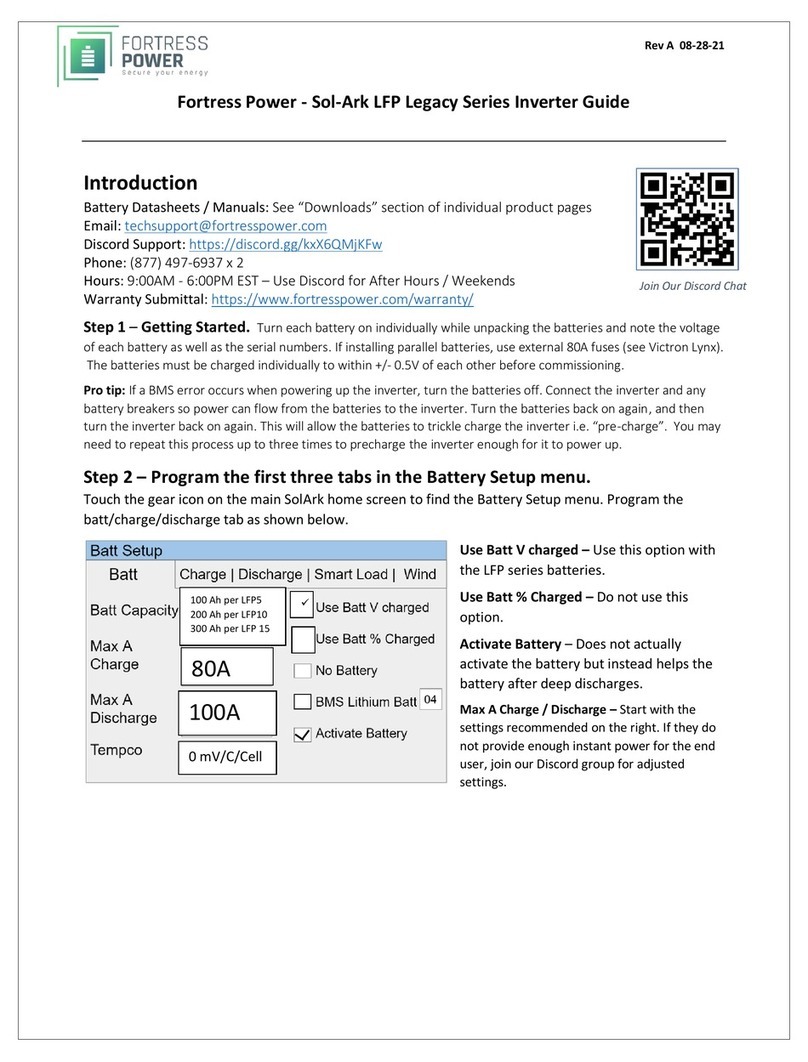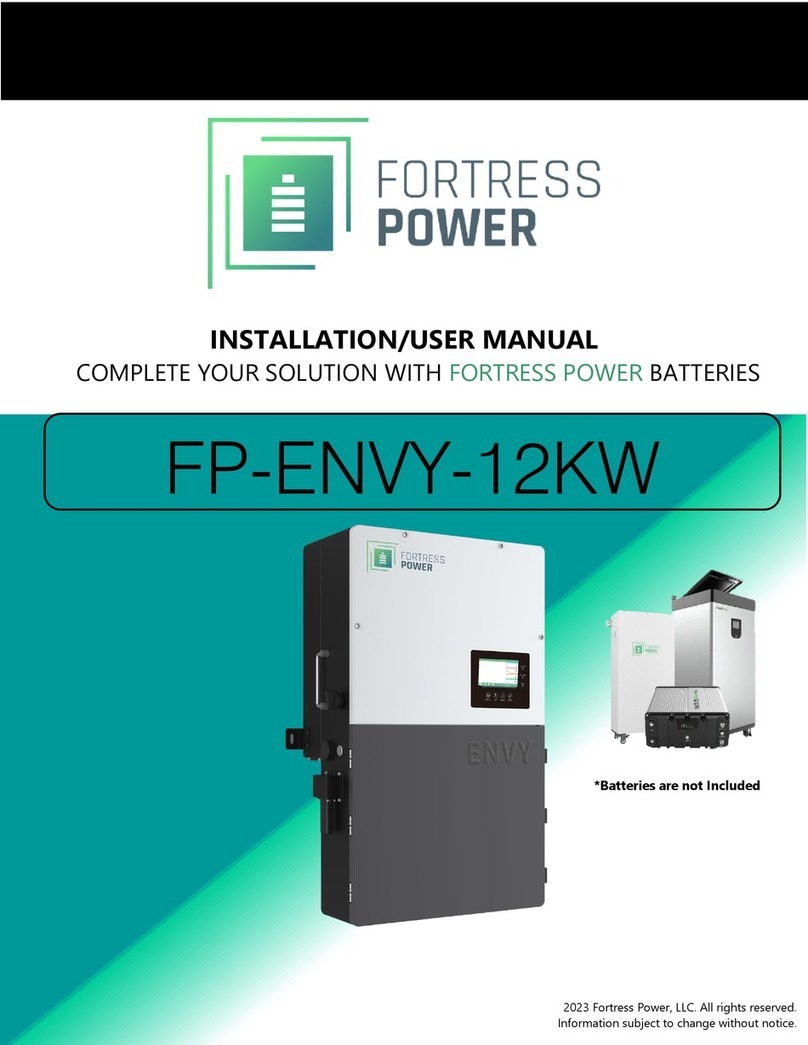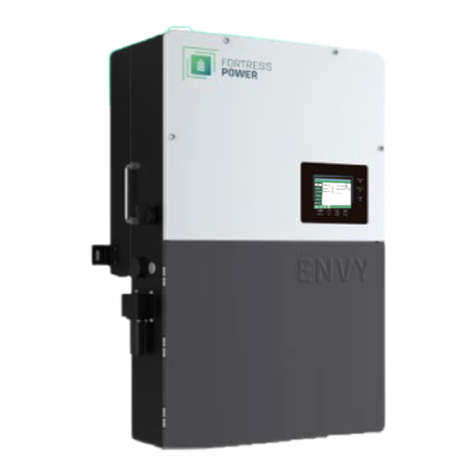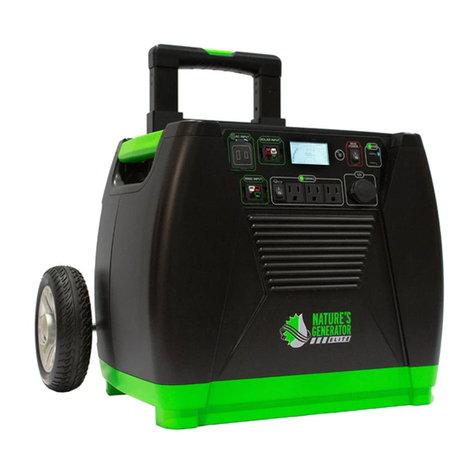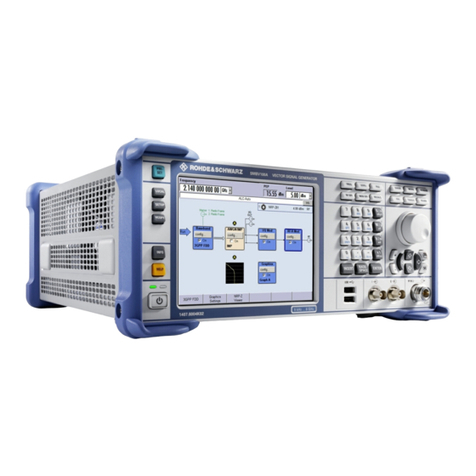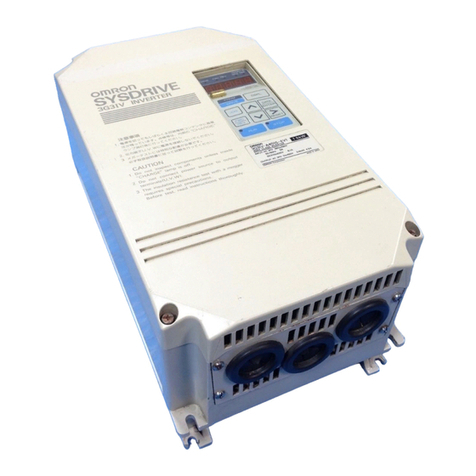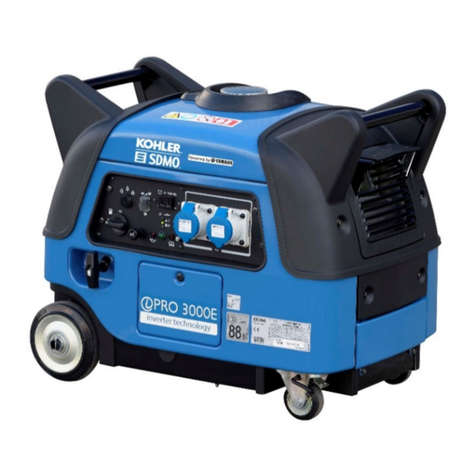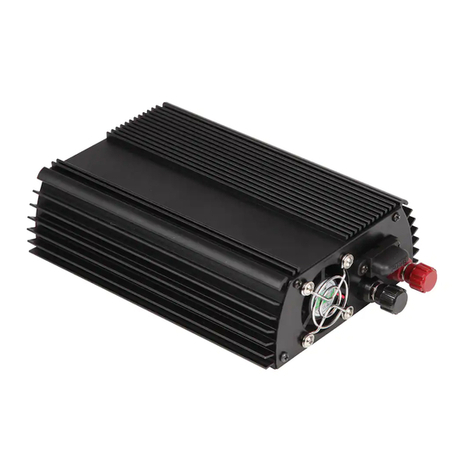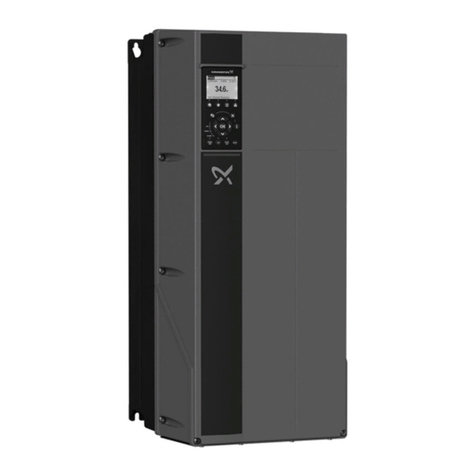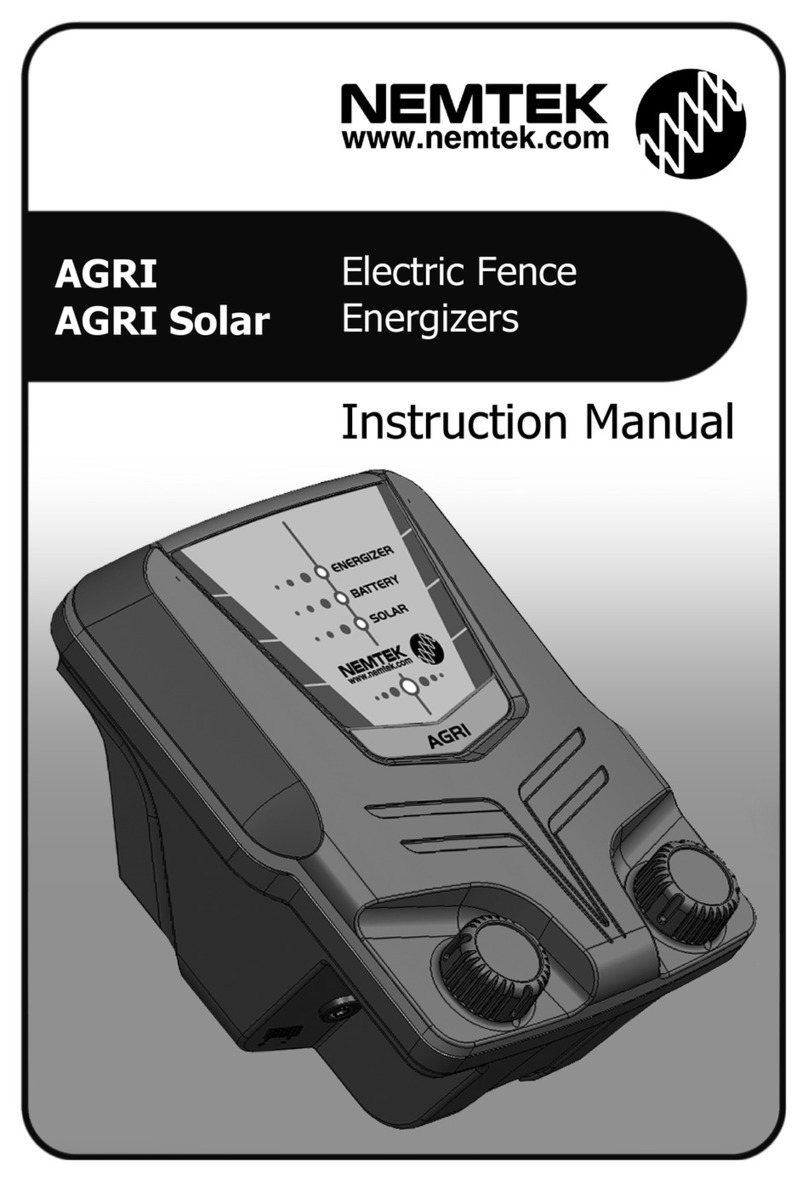Fortress Power FP-ENVY 12K Instruction Manual

INSTALLATION/USER MANUAL
COMPLETE SOLUTION WITH FORTRESS POWER BATTERIES
*Batteries are not Included
FP-ENVY 12K

2
TABLE OF CONTENTS
SAFETY...............................................................................................................................................................................4
SAFETY INSTRUCTION...................................................................................................................................................................................................................................4
BRIEF INTRODUCTION....................................................................................................................................................6
SYSTEM SOLUTION ......................................................................................................................................................................................................................................6
INSTALLATION ................................................................................................................................................................. 7
PACKAGING LIST &STORING .................................................................................................................................................................................................................... 7
LOCATION SELECTION AND INSTALLATION ................................................................................................................................................................................................... 7
Requirements for installation location.................................................................................................................................................................................... 7
Installing the inverter ....................................................................................................................................................................................................................8
CONNECTION OVERVIEW ............................................................................................................................................................................................................................ 10
System Connection ...................................................................................................................................................................................................................... 10
PV CONNECTION ........................................................................................................................................................................................................................................ 12
Battery power cable connection.............................................................................................................................................................................................. 13
Battery communication cable connection............................................................................................................................................................................ 13
GRID &EPS LOAD CONNECTION .............................................................................................................................................................................................................. 14
Grid type and regulation selection ......................................................................................................................................................................................... 14
Grid and EPS load connection for split-phase service..................................................................................................................................................... 15
AC cable connection ..................................................................................................................................................................................................................... 16
CT/Meter Connection ................................................................................................................................................................................................................... 16
WORKING WITH GENERATOR...................................................................................................................................................................................................................... 18
Generator system connection .................................................................................................................................................................................................. 18
Generator Startup and Stop settings. ................................................................................................................................................................................. 20
AC COUPLING INSTALLATION CONNECTION.............................................................................................................................................................................................. 20
PARALLEL SYSTEM CONNECTION ..............................................................................................................................................................................................................22
Connection for paralleling system..........................................................................................................................................................................................22
Parallel information display...................................................................................................................................................................................................... 24
MONITOR SYSTEM SETUP..........................................................................................................................................................................................................................25
Wifi/GPRS/4G/WLAN dongle connection..............................................................................................................................................................................25
Setup the monitor system ....................................................................................................................................................................................................... 26
Set Homewifi password to dongle ........................................................................................................................................................................................ 26
Third party RS485 communication..........................................................................................................................................................................................27

3
OPERATION GUIDE....................................................................................................................................................... 28
OPERATION MODE AND FUNCTION ............................................................................................................................................................................................................ 28
Self-usage Mode (Default)........................................................................................................................................................................................................ 28
Charge First Mode........................................................................................................................................................................................................................ 29
AC Charge Mode ........................................................................................................................................................................................................................... 30
Grid peak-shaving Function ...................................................................................................................................................................................................... 30
Smart load Function.................................................................................................................................................................................................................... 30
RAPID SHUTDOWN...................................................................................................................................................................................................................................... 31
LCD DISPLAY ............................................................................................................................................................................................................................................ 31
Viewing information and alarm/fault record ...................................................................................................................................................................... 31
Setting Parameters..................................................................................................................................................................................................................... 33
START-UP AND SHUT DOWN THE INVERTER .............................................................................................................................................................................................. 35
Start up the inverter................................................................................................................................................................................................................... 35
Shut down the inverter.............................................................................................................................................................................................................. 35
TROUBLESHOOTING & MAINTENANCE .................................................................................................................. 36
REGULAR MAINTENANCE........................................................................................................................................................................................................................... 36
LED DISPLAYS ......................................................................................................................................................................................................................................... 36
TROUBLESHOOTING BASED ON LCD DISPLAYS....................................................................................................................................................................................... 36
FAN REPLACEMENT ................................................................................................................................................................................................................................... 40
ANNEX: TECHNICAL DATA..........................................................................................................................................41
PARAMETER SETTING ACCORDING TO RULE21 ........................................................................................................................................................................................... 41
Enter Service Setting................................................................................................................................................................................................................... 41
High Voltage and Low Voltage Trip .................................................................................................................................................................... 41
High Frequency and Low Frequency Trip.............................................................................................................................................................................. 41
Specified Power factor (SPF)................................................................................................................................................................................. 42
Voltage / Var Mode (Q(V)).......................................................................................................................................................................................................... 42
Active Power-Reactive Power Mode ( Q(P)) ........................................................................................................................................................................ 43
Constant Reactive Power Mode.............................................................................................................................................................................................. 43
Frequency-Watt (FW).................................................................................................................................................................................................................. 44
Voltage-Watt (VW) ....................................................................................................................................................................................................................... 44
Active power limit mode ............................................................................................................................................................................................................ 45
Test parameter tolerances ....................................................................................................................................................................................................... 45
DATA SHEET.............................................................................................................................................................................................................................................. 46
CONTACT INFORMATION............................................................................................................................................48

4
Safety
Safety Instruction
General Safety Instructions
Safety regulations have been strictly observed in the design and testing of the inverter Prior to any work, carefully read all safety instructions and
always observe them when working on or with the inverter. The installation must adhere to all applicable national or international standards or
regulations.
Incorrect operation or work may cause:
•injury or death to the operator or a third party
•damage to the inverter and other properties belonging to the operator or a third party.
Important Safety Notifications
There are various safety issues that must be carefully conveyed prior to during and after the installation, as well as during future operation and
maintenance. The following are important safety notifications for the operator, owner, and user of this product under normal conditions of use..
DANGER
Dangers of High Voltages and Large Current
•Beware of high PV voltage. Please turn-off the DC switch of PV Panel output before and during the installation to avoid
electric shock.
•Beware of high grid voltage. Please turn-off the AC switch at the grid connection before and during the installation to
avoid electric shock.
•Beware of large current of the battery output. Please turn-off the battery module before and during the installation to
avoid electric shock.
•Do not open the inverter when it's working to avoid electric shock and damage from live voltage and current from the
system.
•Do not operate the inverter when it's working, only the LCD and buttons can be touched in limited cases by qualified
personnel,
•Other parts of the inverter can be touched when the inverter is in a a safe state (e.g., fully shutdown).
•Do not connect or disconnect any connections (PV, battery, grid, communication etc.) of the inverter when it's working.
•Make sure the inverter is well grounded. An operator should make sure he is well protected by reasonable and
professional insulation measurements (e.g. personal protective equipment (PPE).
•Inspect relevant existing wiring on-site of the installation is in good condition before installation, operation, or
maintenance.
•Inspect that connections are good between the inverter and PV, battery, and grid during installation to prevent
damages or injuries caused by bad connections.

5
Notice
•Please carefully read this manual before any work is carried out on this inverter, the installation, please keep this
manual carefully stored and easy to access at any time.
•The qualified personnel should have had training in the installation and commissioning of the electrical system as well
as dealing with hazards, also they should have the knowledge of the manual and other related documents. As the
installer or operator, they are required to be familiar with local regulations and directives.
WARNING
Avoid Misoperation and Inappropriate Usage
•All the work of this product (system design, installation, operation, setting, configuration, and maintenance must be
carried out by qualified personnel as required.
•All connections must be in accordance with local and national regulations and standards.
•The inverter and system can inter-connected with the utility grid only if the utility grid permits it.
•All the warning labels or nameplates on the inverter must be clearly visible and must not be removed, covered, or
pasted.
•The installation should consider the safety of future users when choosing the right position and location as specified in
this manual.
•Please keep the children away from touching or misusing the inverter and relevant systems.
•Beware of burning hurt, the inverter and some parts of the system could be hot when working, please do not touch the
inverter surface or most of the parts when they are working. During inverter working states, only the LCD and buttons
could be touched.

6
Brief Introduction
System Solution
This product and its associated system are suitable for the following system applications (system diagram):
A.
Solar and battery storage system
B.
AC Coupling with existed solar system
Existed On-grid
Solar System
C. On-grid solar system without battery (Support
EPS
Load even without battery)
D.
Off-grid and back-up applications
Reserved
Battery &UPS
Interfaces
E. Single and three phase paralleling system
F.
Energy storage system with peak shaving Function
Viewer
Router
Grid

7
Installation
Packaging List & Storing
When the packaging is unpacked, the inner components should match those listed in the list below.
Location Selection and Installation
Requirements for installation location
a) The mounting wall should be strong enough to bear the weight of the inverter. Please maintain the minimum clearances when using
multiple inverters in parallel as presented below for adequate heat dissipation. Other electrical accessories such as the ENVY distribution
Panel may be mounted with a minimum 2-inch clearance on either side of the inverter. If mounted below the inverter fans the minimum
clearance shall be 16 inches.
Expansion Screw
and
Tube x4
Wi-Fi dongle x1
Optional
1" CT x 2
Cross Head Screw
x17
User Manual x1
Battery communication
cable Length
2mx1(Grey)
Parallel communication
cable L=2mx1(Grey)
Bracket: wall-mountedx1
1 ENVY INVERTER

8
a) Never position the inverter in continuous sunlight, rain, or snow when installed in the south side orientation of the property (in reference
to the sun) as this might damage the LCD screen due to excessive UV exposure. If installed in the south side orientation, choose a well
shaded site or a shed to protect the inverter from direct sunlight, rain, and snow etc. Otherwise install in the correct property side
orientation as described in the figure below.
b) The inverter should be installed upright on a vertical surface.
Installing the inverter
The inverter is wall-mounted type and, should be installed on a vertical, solid mounting surface, such as wood studs, brick, or concrete wall. Two or
more persons may be needed to install the inverter due to its weight. The slots on the mounting bracket can accommodate various stud spacings
from 12inches(305mm) to 16inches(406mm).
>75
90
>90
90
2.36
5.7in(145mm)
17.3
n(440mm)
18 in(458mm)

9
The mounting steps are as below: (Use brick wall as example)
1. Mark the drill holes positions with the mounting bracket,
2. Drill four48mm(5/16inch) diameter holes, making sure the depth of the holes is deeper than 50mm(2inches).
3. Install and tighten the expansion bolts into the holes.
4. Then use the corresponding nuts and washers (packaged together with the expansion bolts) to install and fix the wall-mounting bracket on the
wall.
5. Hang the inverter onto the wall-mounting bracket and lock the inverter on the wall using 2 self-tapping screws on the top of the inverter.
For installation on wood studs
Fasten the mounting bracket on the studs with 4 wood screws, then hang the inverter onto the bracket and lock the inverter on the wall with 2 self-
tapping screws.
Please note that the wood screws and self-tapping screws are not provided with the inverter. Installers need to prepare the screws before
installation.

10
Connection Overview
System Connection
The system connection diagram is as below( for US version):
Please prepare the breakers before connecting, breakers selection recommendation for both DC and AC
Inverter model 12K
PV Breakers(2Px4)
MPPT1 string 1 : 600V/20A MPPT1 string 2 :
600V/20A MPPT2: 600V/20A
MPPT3:
600V/20A
Main Breaker(2P) 200A/240Vac when ups is used for whole home backup 100A/240Vac when ups is
used for partial load backup
Generator breaker 100A/240Vac
Overview of Connection Ports
75 mm(2.95in)
95 mm(3.74in) 63 mm(2.48in) 102
63 mm(2.48in)

11
a). DRM port
b). Battery communication port (CAN&RS485) please check Chapter
3.5.2 for Pin definition
c). CT Interface: please check Chapter 3.6.4 for CT connection
d). INV 485: Debugging port
e). Parallel communication port please check Chapter 3.9 for
Parallel connection
f). FAN1/2/3
g). TEMP: Connection for temperature sensor of lead-acid battery
h). Meter 485B&485A: For Meter communication
i). VIN/+12V: Connect a outside emergency switch on these 2
terminals
j). CAN Matching resistance: Set DIP switch when use inverters in
parallel
k). GEN (NO, NC): Connection for generator auto-start function
l). DRY(NO,NC): reserved

12
PV Connection
The PV connection of this hybrid inverter is the same as that of a traditional on-grid solar inverter (string inverter).
Cable Requirement:
Cable Size Minimum Voltage
10-8AWG (5-8mm2) 600V
WARNING
* Please double check the lowest ambient temperature of the installation location. The rated Voc on solar panel nameplate is obtained at
25℃As the ambient temperature drops, the Solar panel Voc increases. Please ensure the Maximum solar string voltage corrected at the
lowest temperature does not exceed the inverter’s maximum input voltage of 550V.
NOTICE
1. The inverters have three MPPTs. For MPPT1, users can connect two strings. For MPPT2 and MPPT3, users can connect one
string.
2. When users connect 2 strings to MPPT1, make sure the two strings have same quantity of solar panels. The inverter will
limit the total MPPT1/MPPT2/MPPT3 input current to
25A/15A/15A automatically.
3. The inverter will limit the max solar input power to 18kW totally.
Steps for PV connection
a) Strip off 1/4-5/16inch(6~8mm) insulation on the PV string’s
positive and negative conductors.
b) Use wire ferrules for PV string conductors if they are
stranded wire type.
c) Insert the conduit fitting into the opening for PV connection
and tighten it from the inside using the counter nut.
d) Route the PV conductors through the conduit fitting and
into the inverter.
e) Secure the cable gland in place.
f) Ensure that the cables are connected correctly and
securely. Then take appropriate measures to ensure that
the conduit and conduit fittings are fastened reliably and
seal the cable entry holes.

13
Battery Connection
Battery power cable connection
Cable Requirement:
1. Strip 1/4-5/16inch(6-8mm) insulation from the cable end and crimp Ferrule for the cable ends.
2. Route the battery power cable, connect positive to BAT, negative to BAT-.
3. Secure the conduit fitting to the enclosure using the counter nut.
4. Fasten the OT rings of battery positive and negative cables to the lugs according to the markings.
5. Fix the cable gland in place.
Battery communication cable connection
Correct battery communication cable must be used to connect the battery to the inverter when users choose lithium-ion battery type. Please select
‘Lead-acid ‘ type if the lithium battery cannot communicate with the inverter. The battery communication port on inverter is an Rj45 socket, Pin for
the RJ45 plug of the communication cable is as below. Make the communication cable according to the below inverter Pin and the correct pinout of
communication port on battery. The inverter supports both CAN and
RS485 communication

14
After battery power cable and communication cable connection, users need to enter Advanced settings and choose Battery type and brand on the
inverter LCD.
Grid & EPS Load Connection
Grid type and regulation selection
The inverter can be used with 120/240V split phase. The inverter has passed the main grid-connection regulations in the US. Users can
choose different Grid Type and regulation in advanced program as below:
Lithium
Select Grid Voltage
240V/120V
208V/120V
Select Frequency
60
Select Grid
Regulation
According to
Region
Lithium 0
48
54.8 54 Select Lead Acid for Open
Loop Settings and
manually configure
charging parameters. The
Inverter will use three
stage charging.
Select Lithium and Lithium
0 for Closed Loop
Communication with
Fortress Power
eFlex, eVault MAX
240V/120V

15
Grid and EPS load connection for split-phase service
Connection diagram for 120/240V is as below.. The inverter can be connected to the load side of the service disconnecting means if the
busbar rating in the main panel can meet the NEC705.12(B)(3) requirements. Otherwise, a Line side connection can be made to avoid
an expensive main panel upgrade.

16
AC cable connection
Cable Requirement:
Current Cross-section Cable Diameter Minimum Voltage Torque for cable connection
100A 3- 2AWG(25-35mm
2 ) 6-7mm 600V 7(N.M)
200A 1/0-2/0AWG(55-70mm2 ) 8-9mm 600V 33(N.M)
a. Strip off 5/16-3/8inch(8~10mm) insulation sleeve on the cables.
b. Use wire ferrules if the cables are made of fine stranded wires.
c. Secure the conduit fitting to the enclosure using the counter nut of the fitting.
d. Fasten the grid and EPS load cables to the terminal block in accordance with the markings.
e. Secure conduit to the conduit fitting.
f. Check that the cables are connected correctly and securely, then take appropriate measures to ensure that the conduit and conduit fitting
are secured reliably and seal the cable entry holes.
CT/Meter Connection
To measure the power imported from and exported to the grid, a pair of CTs or one triphase meter must be installed at the service entry point in or
near the main service panel. We standardly supply 2 CT for one inverter.
CT Port Pin definition
The CT interface for 2 CTs connection is a RJ45 port, We have made a RJ45 plug on those 2 CTs in advance, so you can connect it to the port
directly.
Pin Description
1-4 Reserved
5
CT2N
6
CT2P
7
CT1N
8
CT1P

17
Please refer to the above connection diagram for the correct positions of CTs.
Please clamp the 2 CTs on the L1 and L2 wires at the service entry point in the
main service panel. The arrows on the CTs must point to inverter side.
CT Clamp Ratio
The Fortress Power inverters support two ratios of CT clamp- 1000:1 and
3000:1. The CT ratio of the CTs in the accessory bag is 3000:1. If you are
using a 3rd party CT, please ensure the CT ratio is either 1000:1 or
3000:1, and then select the correct
CT ratio setting in the inverter
monitor page or on the inverter LCD.
Extend CT clamp cable.
The CT wires can be extended with a common ethernet cable if the length is not enough. An RJ45
adapter is needed for the extension. The CT wires can be extended up to 300ft (around 100m)
Alternative Meter
Connection
Currently only EASTRON
SDM630-Modbus meters
can be used. If you need
to use a meter for
import/export detection
instead of CTs, you need
to connect it to the
Meter 485A and 485B
terminals on the inverter.
Fast Zero Export
For Fast Zero Export
applications, CT’s must
be connected between
the Utility Meter and
Main Panel Connection.
5
CT
1
L1
TO
TO Grid
CT
P
TO
TO
Grid
Pin8
Pin7 PN

18
Inverter CT Programming
Working with Generator
Generator system connection
0This hybrid inverter can work with generator. There are Gen ports on the inverter for generator connection.
Ct
3000:1
0:1 phase

19
When the generator is started, all the loads connected to EPS will be supplied by the generator. Meanwhile the battery will be
charged. The pass-through relay on the generator port is 90A. When the generator is on, please ensure the total load and charge
current will not exceed 90A. The generator start signal shall be connected to the COM board GEN (NO, NC port) if users want to start

20
Generator Startup and Stop settings.
Note: Always Make sure you select Set for every change made, otherwise the inverter will not save input parameters.
It depends on the Bat charge control setting; The system will use either battery SOC or battery voltage to determine whether the system needs to
start or stop the generator.
Generator Start Conditions
When utility fails and
-When battery is discharged to cut-off settings
or there is force charge request from battery.
or when the battery voltage or SOC is lower than the Generator Charge start Volt/SOC settings,
Generator Stop Conditions
When battery voltage or SOC is higher than Charge end Volt/SOC settings value.
AC Coupling Installation Connection
The inverter supports AC coupling connection with the existing grid-interactive solar system. The existing solar system is connected to the inverter's
GEN port.
Connection for AC coupled solar system
Set
Set
Set
Set
Use Bat V
Bat charge control Use SOC %
Basic
Charge
Discharge
Advanced
Debug
Device info.
Basic
Charge
Discharge
Advanced
Debug
Device info.
Table of contents
Other Fortress Power Inverter manuals
Popular Inverter manuals by other brands

WEG
WEG CFW-11 Series user manual

Omnia
Omnia Volt Quick start installation guide
National Semiconductor
National Semiconductor LM7705 manual

Mitsubishi Heavy Industries
Mitsubishi Heavy Industries SRR25ZM-S Technical manual
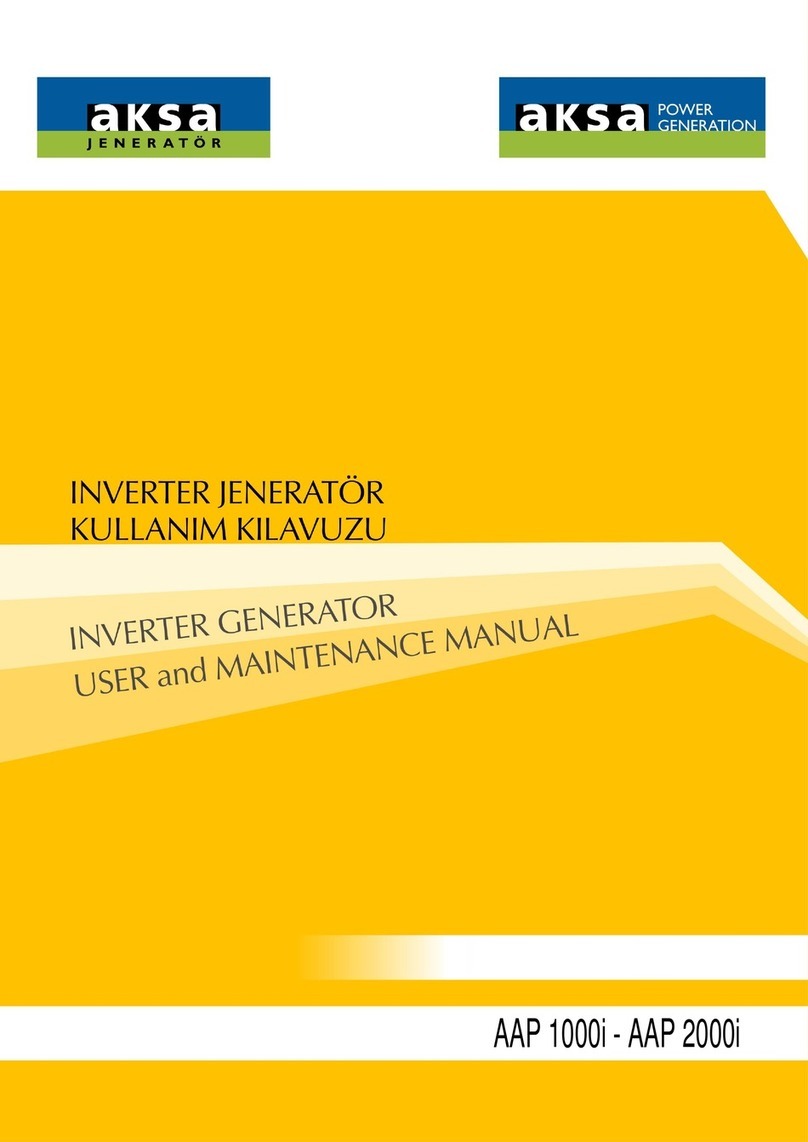
Aksa
Aksa AAP 1000i User and maintenance manual

Turbo Energy
Turbo Energy Lithium Series instruction manual
